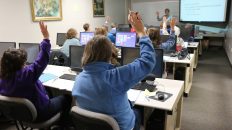INTRODUCTION TO 2D AND 3D ANIMATION
2D and 3D animation course online for teens.Tutorials
Computer animation is the process used for generating animated images by using computer graphics. The more general term computer generated imagery encompasses both static scenes and dynamic images, while computer animation only refers to moving images.
Modern computer animation usually uses 3D computer graphics, although 2D computer graphics are still used for stylistic, low bandwidth, and faster real-time renderings. Sometimes the target of the animation is the computer itself, but sometimes the target is another medium, such as film.
Computer animation is essentially a digital successor to the stop motion techniques used in traditional animation with 3D models and frame-by-frame animation of 2D illustrations. Computer generated animations are more controllable than other more physically based processes, such as constructing miniatures for effects shots or hiring extras for crowd scenes, and because it allows the creation of images that would not be feasible using any other technology. It can also allow a single graphic artist to produce such content without the use of actors, expensive set pieces, or props.
To create the illusion of movement, an image is displayed on the computer screen and repeatedly replaced by a new image that is similar to it, but advanced slightly in the time domain (usually at a rate of 24 or 30 frames/second). This technique is identical to how the illusion of movement is achieved with television and motion pictures.
The general range of enrollment in Teens Computer School in Toronto is between 7 and 17 years old. We offer classes in the most desired areas of expertise in today’s computer-oriented career fields. This knowledge is not only using current information, but can now start to accelerate your child’s future career. The possibilities are endless, including numerous opportunities in the field of computer and graphic design. You as a parent, however, have to make the right choice and we are here to help you and your child to find the right path, discover the talents and encourage development.
For 3D animations, objects (models) are built on the computer monitor (modeled) and 3D figures are rigged with a virtual skeleton. For 2D figure animations, separate objects (illustrations) and separate transparent layers are used, with or without a virtual skeleton. Then the limbs, eyes, mouth, clothes, etc. of the figure are moved by the animator on keyframes. The differences in appearance between keyframes are automatically calculated by the computer in a process known as tweening or morphing. Finally, the animation is rendered.
For 3D animations, all frames must be rendered after modeling is complete. For 2D vector animations, the rendering process is the key frame illustration process, while tweened frames are rendered as needed. For pre-recorded presentations, the rendered frames are transferred to a different format or medium such as film or digital video. The frames may also be rendered in real time as they are presented to the end-user audience. Low bandwidth animations transmitted via the internet (e.g. 2D Flash, X3D) often use the software on the end-users computer to render in real time as an alternative to streaming or pre-loaded high bandwidth animations.
What to do if you want to study animation?
Two simple options:
1. If you live in GTA
– fill up our registration form and start to study next day in the main office of Teens Computer School
2. If you live in Ontario
– Contact school and we will discuss many available options.
3. If you live anywhere in the world
Welcome to Teens Computer Online School





